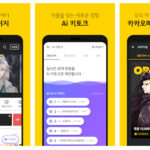The “Contactless” Marketing Trend in the Era of COVID-19

The pandemic has changed the publishing industry
The virus, COVID-19, struck global industries and economies in January 2020. Our daily life has changed completely as well. The schools’ administration system almost froze as all the schools postponed the new semester. Libraries, art museums, museums, and stadiums had to close due to social-distancing. Schools that postponed the new semester a couple of times chose to open classes online. Publishers had to grope in the dark, putting a halt to publications or promotions of new titles that they have long been preparing for. It was a total nightmare. While all the cultural markets were engulfed in endless darkness, it was yet good news that the book market saw a relatively satisfactory performance.
The virus-driven shock to offline bookstores was dire. However, for online bookstores, their sales record soared, led by children’s and teen books. For example, Kyobo Bookstore, which is the only bookstore in Korea that keeps balance in running both of its on- and off-line channels, saw a 7.3% increase in sales year on year in 2020. This performance was driven by online sales, where 32.9% more people bought books on their mobile device, while 20.1% more bought them online compared to last year, offsetting the 15.9% drop in offline sales. Some big publishers that produce children’s and teen books grew by 30-40% compared to last year, but still, small bookstores had a tough time last year. This implies the deepened polarization within the publishing market.
The growth of online bookstores in Korea is well reflected in the “Online Shopping Trend Survey” announced by Korea Statistics. Their sales from the first to the third quarter in 2020 increased by 28.9% year on year. While the sales for the fourth quarter have not been announced yet, the gradually growing quarterly sales on year (16.9% for the first quarter, 35.0% for the second quarter, and 37.4% for the third quarter) hints that the momentum is likely to continue in the fourth quarter as well. Perhaps this has led Coupang, a giant e-commerce company that grew exponentially in 2020, to launch a book business, heralding an upheaval in the market.
The sales of offline bookstores have been dire due to the pandemic, whereas online bookstores experienced a large jump.
Publishers postponed publications of major highly-anticipated titles last spring. All offline events were canceled. Authors who managed to publish their books in the market could not run promotions as offline book talks and lectures were canceled, leading to a drop in their income. They faced a tremendous challenge as libraries also closed their doors. Emergency aid was arranged, but it was also just a quick fix. The publishers had encountered a crisis that had no end. The whole publishing market had sunk into a swamp.
The silver lining was the advanced delivery system. The parcel delivery system in Korea worked as a tool that breathed life into the overall Korean economy. It was verified that businesses could grow once they secure a means that directly connects producers and consumers in the hyper-connected society. However, even publishers that progressed rapidly could not reach a consensus among themselves. While books for adults excluding those related to financial management and investment could not recover their sales, children’s and teen books made great strides in performance.
Meanwhile, steady-sellers among the children’s and teen books where their quality has been verified began to show their potential. While the sales of recommended, award-winning, and textbook-included books soared, that of secondhand books dropped significantly as people were concerned about any possibility that the books may have been exposed to the virus. The popularity of series that made children indulge in reading once they flipped over the first page skyrocketed. The best example was The Mysterious Candy Store (Gilbut School) by Reiko Hiroshima. As such, there’s always a hero amidst the turbulent times.
Korean publishers responding to the pandemic
1) Books becoming multimedia
The pandemic has brought about a rapid change in the publishers’ production and marketing system. Publishers aggressively took actions to make books go multimedia, such as audiobooks and e-books. Readers that could not borrow paper books from libraries turned their eyes to e-books and audiobooks. Large bookstores that were reluctant to publish children’s books eagerly jumped into the production and distribution of such types. Editors who believed that children should see and feel the exciting stories, pictures, and information through paper books had no way but to change their ideas to respond to the prolonged situation driven by the pandemic.
Content for toddlers and pre-schoolers based on smartphones or digital devices has been vigorously expanding its influence in the market before this trend started. Prepared large publishers that specialize in educational materials welcomed the change. The pandemic was a wake-up call for those who used to put weight on analog-style production that they should not put aside technological advancement any longer. Not only editors, designers, and marketers, but also authors had to change their way of thinking in order to create quality digital content. The excuse that it is hard to expect profit from digital content while it requires much expense, time, and labor has become an outdated idea in the current situation.
The pandemic-driven situation in the publishing market did not wait for late comers. Publishers were sure that they would be left out of the industry if they didn’t produce and distribute digital content as they do for paper books. The new-normal of online classes in society has even changed the way we read and have class at school. Online classes began to make great use of video materials such as audiobooks, movies, or animations. The QR codes printed in books enabled better access to digital content. Teachers connected authors to their class through Zoom, raising efficiency.
Publishers hurriedly set up video equipment and looked for specialists. As they realized that it was not enough to rely on hiring a third party to produce book trailers and requesting popular Youtubers to introduce their books for promotion, they started to hire manpower to make videos by themselves. They vigorously opened a channel on a video platform to promote their books. It was a default for authors to meet readers through lectures once they publish a new book. However, the pandemic has canceled all such interactive schedules. Thus, writers that used to give lectures to hundreds of children readers at libraries had to meet them online at the publisher’s office.
2) Emergence of the millennials
In the 1990s, quality children’s books were published. People who fought against the dictatorship were full of zeal for making fine books for their children. The millennial generation who grew up reading those books recommended by their parents have become parents themselves. The so-called “kidults (kid + adult)” aged in their 20s and 30s tend to look for enjoyable and entertaining things, while they not only like collecting goods but also like searching for toys, comics, biscuits, or clothes that used to be a trend in their childhood. They have a high standard when choosing quality products and content, and have consumer power in that they generally do not care how much products cost. The most important thing is that they are familiar with multimedia.
Such capabilities of the millennial generation are greatly transforming the marketing trend. For example, during the late 2010s, liberal arts for entertainment had been the trend, where the broadcast was combined with liberal arts. As artificial intelligence emerged in this generation, liberal arts was not contained to literature, history, and philosophy. On TV, scholars from various fields such as philosophy, history, science, architecture, food, art, and psychology began to appear as “infotainers (information + entertainer).” However, to become an infotainer, one had to publish a book. Those that have not written a book could not have their popularity guaranteed.
Kim Jae-Won, the head of content planning and management in Alda, explained how liberal arts in entertainment has totally changed the trend in the publishing market in Infotainer, growing into Edutainer – Reshaping the “liberal arts entertainment” system announced in Gihoeghoeyi Vol. 531 (March 5, 2021). The changing trend was not limited to regular broadcast programs. It was actually not that lucrative to “sell liberal arts” on TV, and it was merely a means to add a nice line to the edutainers’ career. To actually make a profit out of “selling liberal arts,” they had to utilize Youtube with high public and brand awareness. Youtube would be a more stable source of income than going on a TV show if they could increase the number of subscribers and views.
Marketing trends in the publishing industry changed by Youtube
The public awareness built through TV programs put the edutainers on a different starting point in the Youtube market. It is almost impossible to succeed as a content creator on Youtube if you lack good enough content to show. However, the edutainers that collaborate with broadcast companies begin Youtube with “extraordinary” videos. This is different from reruns on TV. The knowledge delivered on TV is broken down into smaller pieces on Youtube, and they turn into memes made of screenshots on the Internet.
Here, the last runner is the publisher. For publishers, Youtube was such an attractive channel for promotion. While it had been deemed as a “success” in the liberal arts market if a title sells 2,000-3,000 copies in the past, today, books are selling hundreds of thousands of copies in the liberal arts publishing market. Once a book becomes a bestseller, the edutainer that has become a popular writer takes the book again to the broadcaster. A new TV show is made based upon it, and content that stems from that program is reproduced on Youtube. This leads to more sales. In short, it is like a cycle, and this system has become mainstream in the content market.
Therefore, some of the large bookstores are continuing their success story by promoting a membership business with readers, integrating all the online marketing channels they have. However, most of the small- and medium-sized publishers lack the ability to carry out marketing activities. Writers with a big fanbase or famous edutainers are showing a willingness to publish books by themselves. In other words, they are even breaking down the boundary between commercial publishing and independent publishing. It is less effective to buy a shelf and display books in offline bookstores for promotion anymore. The advertisement effect of the old media has long been gone. The impact of advertisement pop-ups on the main page of online bookstores has dropped significantly as well.
In 2019, there was a rumor that popular Youtubers make books go bestsellers. One year has passed, and they have totally transformed the marketing trend. Now, books’ exposure on Youtube lacks efficiency if the publisher does not actively participate. Also, book promotions through Youtubers have lost trust among viewers after the “secret advertisement (where Youtubers pretend to have not received money for advertising a product and say that the evaluation or purchase is based on their personal opinion)” became a social issue. Furthermore, authors that have a fanbase attempted to advertise their books through Social Media, card-styled news, and outsourced channels (Sohaengsung Chaekbang (Asteroid Bookstore), Dog-ear (Chaekkutul Jeopda), etc.), but are getting more anxious as such attempts are not as effective as they cost.
The “contactless” trend driven by the pandemic is expected to increase the number of books that utilize collective intelligence.
The only alternative that publishers hang onto is inviting authors to schools, where they can advertise their book in online classes using Zoom. There is all the necessary equipment in school for online classes. It was educationally effective for writers to give lectures during online classes directly. Famous authors have hundreds of lectures throughout the year. Therefore, online classes are likely to be used as a channel for delivering lectures even though things return to normal after the pandemic.
Online meetings or classes have become a part of our daily life. Zoom or Cloud turns verbal discussions into texts. Therefore, there will be more books that utilize collective intelligence. Publishing books that talk about meaningful topics would be a shortcut for publishers to survive in this rapidly changing world. The “contactless” social trend brought by the pandemic is transforming everything in the industry from production to marketing and consumption.
Written by Han Ki-Ho (Head of the Korea Marketing Research Institute)












